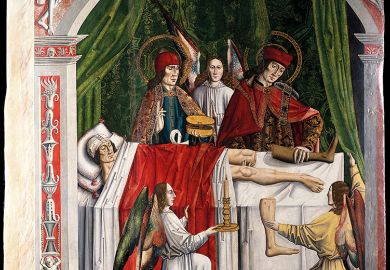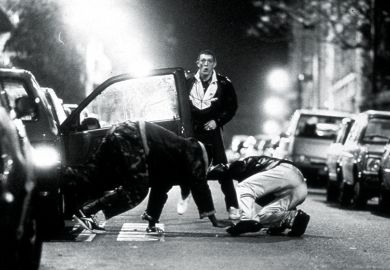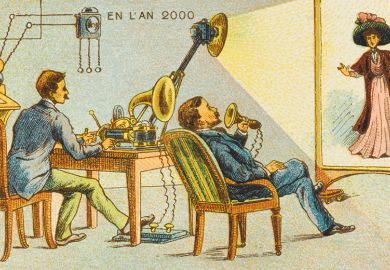Ian McEwan once memorably described hearing a BBC Radio 4 adaptation of one of his novels as like seeing a familiar face that had some of its teeth missing. The experience of reading Elements of Surprise is not dissimilar. Old favourites – Emma, Great Expectations and McEwan’s own Atonement, among others – appear reworked, done over by a different discipline. They emerge not so much with missing teeth as with a previously familiar element surgically enhanced. This is not to the detriment of the novels, but it does make for a defamiliarising and challenging new reading experience.
Vera Tobin approaches a set of mainly 19th- and 20th-century novels and films as a cognitive scientist, determined to understand the ways in which readers’ and viewers’ brains collude with the creators’ intentions to produce the “element of surprise”. Surprises rely, as Tobin argues, on cognitive bias – and are often seen primarily as part of the repertoire of light reading. Yet in fact, she claims, surprise operates as part of a complex narratorial as well as cognitive process. It works to help us distinguish between points of view, to be alert to misdirection and then to acknowledge the seductive power of narration: while poorly constructed surprises can leave us feeling cheated, a good surprise can be a delight.
In Elements of Surprise, John le Carré rubs shoulders with Agatha Christie, Jane Austen with Graham Greene, in a wide-ranging analysis of a trope and practice that moves across all genres – and that is far from restricted to classic detective fiction.
That said, part of the pleasure of this book is that it insists that a good detective story’s surprise can be as satisfying and as skilfully wrought as any other successful narrative. Readers are invited to consider how sleights of hand, or an Agatha Christie plot, work time and again, how plot twists “capitalize very efficiently on general shortcuts and biases in our cognition. They use fundamental tendencies of our own minds against us – but also, ultimately, for us, because these tendencies are in a sweet spot of conscious accessibility that allows us to recognize them when we fall prey to them even as we are not quite able entirely to control or suppress them”.
Successful, apparently “formulaic”, novels hit the sweet spot through their planting of knowledge that will go “unconsidered or misinterpreted” until it is needed to generate a solution that then entails a rereading or reconceiving of a known set of circumstances. Tobin’s careful analysis of the mechanics of “surprise” fully mobilises the cognitive sciences as provocative and valuable literary critical tools.
We might already be acquainted with this process in specific genres, but her readings of a range of texts produce less familiar experiences when we’re asked to think about Great Expectations, Emma and Atonement as vehicles for the surprises that the novels contain. In terms of Great Expectations, that means that we might read the novel not from the vantage point of its conclusion when Pip achieves maturity but can dwell on the middle parts of the novel, on “the experiences of surprise and sympathy that go hand in hand” throughout the text. Indeed, Tobin argues, Pip’s process of growth and forced renunciation of his first deductions about Estella and his own benefactor act as a prototype of the process through which a reader has to go. Surprises and revelations depend absolutely on resisting or renouncing initial readings and interpretations, on admitting that we got it wrong, as Pip has to do.
In order fully to satisfy, the revelation has at least to enable us to become better readers, as Pip arguably is allowed to become a better man as a result of his painfully acquired knowledge. This is not to say that our cognitive biases will be overridden as we acquire a greater repertoire of narrative surprises, but that we will perhaps better understand the extent to which our reading and viewing pleasure depends on the frisson of manipulation, of knowing we’ve been had, and how a writer or director can orchestrate and then lead us out of the moment of revelation.
Tobin argues that the surprise plot is a “trope of retrospection” and one that depends on “the interplay of multiple perspectives”. As such, it’s not spoiled by rereading: it’s based on a form of rereading while still being part of the act of reading for the first time. While we’re reading, or watching, “some new, superior interpretation of what has gone before” is revealed. The audience is ideally profoundly satisfied by that revelation, especially if it is explicitly acknowledged and recognised by characters within the story.
One of the best cinematic reveals, which Tobin discusses briefly here, comes at the end of Bryan Singer’s The Usual Suspects (1995), when Chazz Palminteri’s detective realises the lies that Kevin Spacey’s character, Verbal Kint, has been telling him – and when as viewers we see Kint’s broken shuffle morph into confident pacing. The power of that chilling image doesn’t come from its being embedded back into a narrative, but in its being left with us as readers to acknowledge, without the support of an ongoing narrative, how we’ve been played.
While we might enjoy the sinister frisson of the end of the film, this example also highlights a certain passivity that lies at the heart of the surprise. It feels as if we in the audience are always subject to the creative direction of a storyteller and that there is little room for our own independent interplay with plot. That said, Elements of Surprise is a fascinating analysis of an element of plot that we might just take too much for granted.
In her 1859 short story, The Lifted Veil, George Eliot uses a first-person narrator, the reclusive Latimer, to consider the plight of someone who believed he could not be surprised. Latimer foresees not only minute details of places he’s going to visit, but believes he can read the minds of those around him. The only person whose mind he can’t penetrate is the beautiful Bertha. It’s her whom he marries, so desperate is he not to know, to be surprised.
Eliot reveals the desire for mystery as a fundamental part of human relationships, as well as the workings of narrative. But Bertha’s mind hides her secret desire to murder her misanthropic husband. That revelation points to the necessary dangers of the unknown and the compulsion to try to penetrate mysteries, as well as signalling the challenge for the writer of holding and withholding knowledge. The “curse of knowledge”, as Tobin convincingly argues, is at the heart of surprise and its cultural manifestations – but it is also fundamental to the acts of writing, reading and their attendant pleasures.
Gail Marshall is head of the School of Literature and Languages at the University of Reading.
Elements of Surprise: Our Mental Limits and the Satisfactions of Plot
By Vera Tobin
Harvard University Press, 344pp, £25.95
ISBN 9780674980204
Published 16 April 2018
The author
Vera Tobin, assistant professor of cognitive science at Case Western Reserve University, in Ohio, was born and raised in Pittsburgh, Pennsylvania. When she was small, she recalls, “my mother was a picture framer and my father was giving guitar lessons between playing jazz gigs at a local club, but our house was always full of books. Even now, whenever I visit my mother, I immediately go to her shelves and browse for something new and interesting to read.”
She studied for her first degree at Brown University, in Rhode Island, which Tobin describes as “a splendid place to be if you liked school but were also perhaps a bit less into buckling down to study just one thing and more into smoking clove cigarettes and taking a wild assortment of apparently unrelated courses…That training served me well when I went on to my graduate studies, as it left me entirely confident that there was no reason not to study cognition, linguistics and literature all at once”.
Always a voracious reader and movie fan – “Trash and treasure, I devour it all” – Tobin “thinks the most enjoyable thing to do after watching a film is to sit down with a friend and take it to pieces. Not everyone is equally excited to indulge me in that sort of conversation, though, so it’s only natural that I found an outlet for it in my academic work.”
While “cognitive science exposes some of the underlying mechanics of a story”, Tobin is also convinced that “it can help us appreciate the craft behind the pleasure, a bit like enjoying a film and also being really excited about the cinematography. But, too, narrative pleasures can shed light on our cognition in ways that traditional behavioural studies can’t capture by themselves. They’re a vast laboratory, with thousands of experiments waiting to be read.”
Matthew Reisz
POSTSCRIPT:
Print headline: A book of revelations
Register to continue
Why register?
- Registration is free and only takes a moment
- Once registered, you can read 3 articles a month
- Sign up for our newsletter
Subscribe
Or subscribe for unlimited access to:
- Unlimited access to news, views, insights & reviews
- Digital editions
- Digital access to THE’s university and college rankings analysis
Already registered or a current subscriber?








